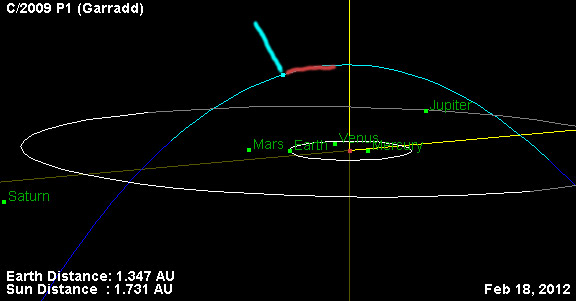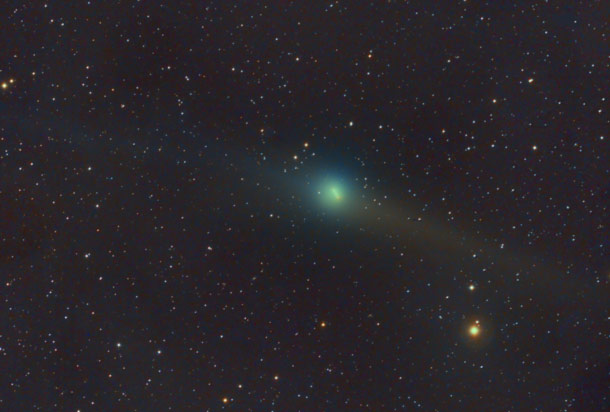Create a free profile to get unlimited access to exclusive videos, sweepstakes, and more!
The two tails of Comet Garradd

César Cantú is an astrophotographer in Mexico. I follow him on Twitter, and hardly a week goes by without him posting a link to some amazing picture he's taken of a celestial object.
And this is no exception: here is his image of Comet Garradd, a chunk of ice and rock that's currently about 200 million kilometers (120 million miles) from Earth:
[Click to encomanate.]
Isn't that lovely? The comet itself is a bit smeared out since it moved over the time as the picture was taken. But even so, wait a sec -- you may have noticed something else odd about this picture. Comets have a tail, right? So why do you see two tails, a blue one pointing off to the left and the other reddish, pointing off to the right?
Aha! Oh, I love a chance to lecture a bit. Bear with me. This is cool.
As I said, comets have a lot of ice in them. As they near the Sun that ice warms, and turns directly into a gas (that process is called sublimation). This gas expands away from the solid nucleus, forming a fuzzy cloud called the coma (Latin for "hair").
Now this is where things get interesting. This coma has both gas in it as well as dust and grains of rock carried off as the ice goes away. The Sun blows out a wind of subatomic particles called the solar wind. This ionizes the gas -- strips off one or more electrons -- and that gas then gets dragged along with the solar wind. That wind is moving, traveling at several hundred kilometers per second, far faster than the comet moves. So that tail gets blown directly away from the Sun. It tends to be blue (or sometimes green), due to the ionized gas in it.
But the dust and rock isn't affected as much. As it moves off the comet, it tends to lag behind a bit, following the comet in its orbit. This material reflects sunlight and also reddens it a bit, so that makes the dust tail look yellow or red.
And that's why there are two differently colored tails pointing in different directions! You can read more about this here.
In fact, I can show you what's going on even better. The JPL website has an orbit simulator for comets and asteroids, and I created a diagram for Comet Garradd for when César took his picture:

The Sun is in the center, and the planets are labeled; I deleted the orbits for all the planets except Earth and Jupiter so you can get a sense of the plane of the solar system. The comet is in blue, and as you can see its orbit is not at all aligned with the planets; it punches upward through the plane on the right, and then plunges back down on the left. It may be hard to get a 3D image of this in your head, but I added in the two tails: the blue ion tail pointing away from the Sun, and the redder dust tail lagging behind the comet itself. From the viewpoint of the Earth, "underneath" the comet, the tails appear to be on opposite sides of the comet and pointing in opposite directions! It's just perspective making it look that way; at this point in the comet's orbit the tails are actually closer to 90° apart.
Strange, isn't it? I've found that three-dimensional thinking is one of the tougher barriers to people really understanding how objects move in space (that, and the vast physical scale of space that crushes our minds to dust). But perspective counts! In astronomy, as well as life itself. And when you get a little perspective, why, sometimes things are even cooler than you first thought.
Image credit: César Cantú.
Â
Related posts:
- Ten Things You Donât Know About Comets
- One more Lovejoy time lapse⦠maybe the last
- The Sun fries a comet and we got to watch
- The WISE family comets
Â















